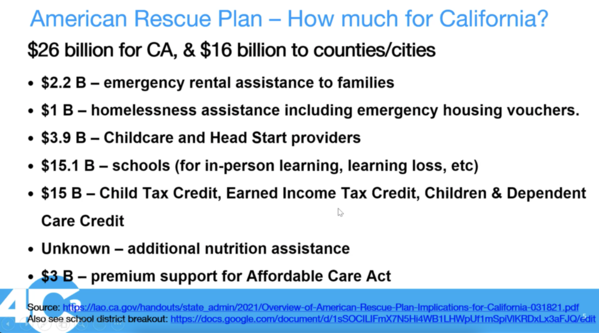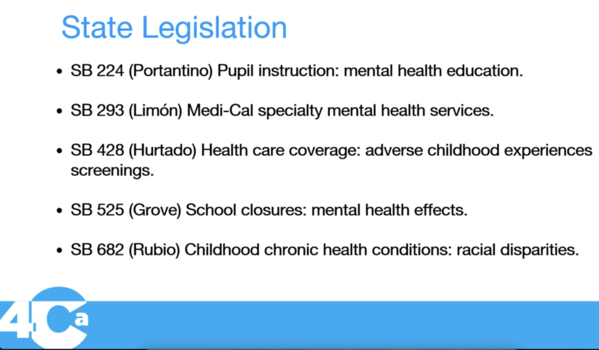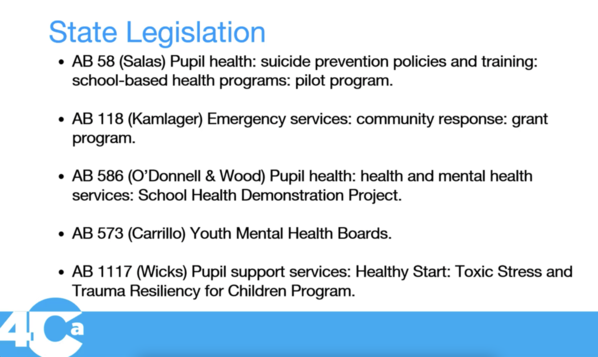California will receive $26 billion through the American Rescue Plan Act (ARPA), the federal legislation recently signed into law by President Joseph Biden to help state and local economies recover from the pandemic. Media outlets have reported that the money will help fund everything from a stronger COVID-19 response to small businesses, housing, anti-poverty programs, and education, but little has been written about the other ways the act will benefit children.
The law’s impact on children’s health and well-being was the subject of a March 30 webinar sponsored by the California Campaign to Counter Childhood Adversity. The audience learned how children will benefit from that federal money and from pending state legislation meant to help prevent and mitigate childhood trauma and promote positive childhood experiences and well-being. The speakers included Kelly Hardy of Children Now and Scott Ogus, a consultant for the California State Senate Budget and Fiscal Review Committee.
“One of the big headlines from the American Rescue Plan Act is that it will cut child poverty in half,” said Hardy, who is the senior managing director of health and research for Children Now. This is being done through changes in the child tax credit. Through ARPA, all families with annual incomes up to $150,000 will receive $3,600 for each child under the age of 6 and $3,000 for each child 6 and older, paid out in monthly installments. ARPA will lift 4.1 million children above the poverty line – reducing the remaining number of children living in poverty by more than 40%, according to the Center on Budget and Policy Priorities.
Included in the plan, she pointed out, are funds to assist families with emergency rental assistance, emergency housing vouchers, and children and dependent care credit, as well as an infusion of money to help schools get students caught up in their studies.
Funding for mental health
Less frequently mentioned was the news that funds could be used to boost children’s mental health, including the psychological consequences felt by children isolated from extended family and their peers in school during shelter-in-place orders. Between April 2019 and April 2020, for example, mental health visits to emergency rooms rose by 24% for 5- to 11-year-olds and 31% for 12- to 17-year-olds, according to a report in the Centers for Disease Control and Prevention’s Morbidity and Mortality Weekly Report.
Hardy directed attendees to an analysis of the American Rescue Plan Act by the Campaign for Trauma-Informed Policy & Practices, which cited three areas in California where the federal law will provide funding for children and youth mental health: community mental health block grants, youth suicide prevention and community-based mobile crisis intervention services.
Scott Ogus, a consultant on health issues for the California Senate Budget Committee, told attendees that the new federal law will also help babies by providing additional support to mothers suffering from post-partum depression. They currently are entitled to mental health support for 60 days, but Ogus said that coverage will be extended for a full year “to make sure that all maternal mental health and other health needs are taken care of.”
Additional money from the state
Besides helping children by supporting maternal mental health, Hardy said, other bills to help prevent and mitigate childhood adversity are making their way through the Assembly and the Senate. One is Senate Bill 428, which would expand the state’s program to screen children for adverse childhood experiences (ACEs) beyond the kids served by Medi-Cal. SB 428 would require that private insurers reimburse health care providers for screening their patients for ACEs.
A bill that stands out for Hardy is Assembly Bill 573, which ensures that young people have a voice in policies that will directly affect them. AB 573 would use funds from the Mental Health Services Act to set up a Youth Mental Health Board within the Department of Health and Human Services to advise the governor and the Legislature.
“That’s exciting because there would be 15 members between the ages of 15 and 23 who would be weighing in on services meant for them,” Hardy said. Half the board, she explained, would be youth who themselves are receiving mental health services.
Besides reviewing bills that are in the pipeline, Hardy pointed out other areas that policymakers say need funding – including helping parents who have been working remotely get back to the office. One such ask is a large infusion of funds ($125 billion in new state funding and $3.75 billion in federal funding) to stabilize and expand childcare in California. Some 8,045 child care facilities have been temporarily closed during the pandemic. Another 2,160 child care facilities have permanently closed since March 2020, according to a recent hearing at the Senate Budget and Fiscal Review Committee.
Hardy did a quick review of where things are in the budget review timeline: Gov. Gavin Newsom introduced his budget in January. The legislature has produced its analysis of the budget, and now advocates and other stakeholders are participating in hearings, which will culminate in a revision of the budget in May – something that child advocates are eagerly anticipating.
How we can help
The audience had questions on how best to support expanded funding for children’s welfare. Among them were:
- In the legislative timeline, when is the best time for advocates to educate lawmakers about bills of interest?
To Hardy, the best timing is “early and often.” More specifically, she said, “The fall is when you should be putting forward bill and budget ideas and meeting with [legislative staff].” That’s also the time to weigh in when you oppose legislation, citing specifics of why you oppose it.
Ogus agreed that educating legislators early is best. He also suggested that when weighing in on budget bills, for example, advocates need to include fully fleshed-out letters that include “statutory language that we need to include, or language that’s included in the budget act.”
He also said that advocates should act like lobbyists, making sure that their most important points are pounded into legislators’ collective consciousness.
When the governor’s revised budget comes out in May, he said, “…Our leadership staff and budget staff on both sides sit down and we think how we can free up some money to fund legislative priorities.” They figure it out on the Assembly and Senate side and take that figure to the majority Caucus. “And the [majority] caucus looks at their list of priorities …and they go down the list until they run out of money. So, figuring out how to get your proposal high enough on that list is the name of the game.”
- If advocates already have working relationships with stakeholders, such as health insurance plans and county offices of education, what’s an effective way to educate them to enlist their support for school-based mental health legislation?
Ogus suggested that advocates spend time educating health plan providers about the benefits of school-based mental health legislation to get them on board. What the legislation is saying, he said, is, “All right, health plan X, we’re going to give you an extra 5% in your rate payment that we pay you for each kid, if you agree to create a partnership with your school district and your county mental health plans to provide services on campus.”
Ogus said that having health plan support is essential for legislation to be approved, put into effect and made available across the board. “Unless there’s coordination to provide the full continuum of services that are available to kids, we’re going to have all sorts of barriers.”
Stay tuned for a link to the entire webinar here. Please see the attached slides.







Comments (0)